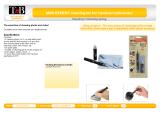
User’s Manual ENGLISH
Names of the parts
Please read before use.
This marine case is a precision instrument designed to permit safe
video recording under high water pressure. Please pay careful
attention when handling the unit before and after use, as explained
in this user’s manual.
Each part of the marine case has been subject to strict controls
during the manufacturing process, and the individual functions
have faced stringent tests during the assembly process. Each marine
case has also had to pass water-proof inspections using high-
pressure water testers. However, damage can sometimes occur
during transport and distribution, or during storage after purchase,
so before diving always carry out the following pre-use test to
verify safety.
Pre-use test
Be sure to perform the following pre-use test before diving.
1. Before mounting the camcorder inside the marine case, dive
with only the empty marine case and test for water leaks.
• You can easily check for water leaks at a depth of 1 m, where
there is no water pressure. Be sure to perform this test to
ensure the safety of your camcorder.
2. The following are some common causes of water leaks:
A. The marine case is used without attaching the O-ring.
B. The O-ring is not mounted in the correct position.
C. The O-ring is damaged or deformed.
D. There is sand, dirt, hair or other foreign matter on the O-ring.
E. There is sand, dirt, hair or other foreign matter on the contact
surface of the O-ring or on the inside of the lid.
F. The provided strap or silica gel bag is pinched inside the
marine case when the lid is closed.
To protect your camcorder and ensure optimum use, keep the
examples listed above in mind when using the marine case.
JVC accepts no responsibility for water leakage or damage to
anything inside the marine case (camcorder, cassette, etc.) due to
careless usage of this product. Be sure to follow correct procedures
when using the marine case.
1
....... Marine case front lid
2
....... Buckle
3
....... Power dial
4
....... Zoom lever
5
....... Recording start/stop button
6
....... Still (snapshot) button
Mounting method and operating method
for each part
1. Remove the camcorder hand strap or grip strap.
2. Remove the four buckles on the marine case and open the
front lid.
3. Align the mark on the marine case’s
Power Dial with the mark on the
marine case.
4. Set the camcorder’s Power Dial to
“OFF”, then open the LCD monitor and
insert the camera into the marine case.
Place the included anti-fogging silica
gel in the gap between the camcorder
and the marine case to prevent fogging in the marine case.
• If the camcorder’s Operation Switch is set to “
”, perform
settings as required then insert the camcorder into the marine
case.
5. Fit the Power Dial projection on the
marine case over the outer groove of
the Power Switch on the camcorder,
making sure that it is securely fit.
If the camcorder’s Power Switch is
set to the wrong position when the
camcorder is placed in the marine
case, the Power Dial aligning boss on
the marine case may be damaged and
the camcorder’s Power Switch may skid.
6. Before sealing the marine case, check that there is no sand,
dirt, or other foreign matter on the O-ring mounted on the front
lid or on the O-ring contact surface on the main unit.
Also make sure that the inserted silica gel bag is not pinched. If
you dive with foreign matter trapped in these areas, water will
leak.
7. Check that the O-ring on the front lid is
correctly mounted in the groove, then
press in the front lid. Flip down the
four buckles in the directions indicated
by the arrows in the figure on the right
to seal the marine case.
8. Turn the marine case’s Power Dial in
the direction of the arrow to set the
camcorder’s Power Dial to “
”.
9. To start video recording, press the
Recording start/stop button. To stop
video recording, press it again.
• Press the Still button to perform
Snapshot recording. If the flash is
used, its brightness will be darker
than usual due to the marine case.
This is normal and is not a
malfunction.
10.The zoom can be adjusted with the Zoom Lever.
11. When you are finished shooting, turn
the power dial to the right to switch
the camcorder power dial to the Off
position.
NOTES:
n The O-ring is made from rubber and is
mounted on the front lid.
n Refer to the camcorder’s instructions for
more information.
3
2
1
2
4
5
6
For Digital Video Camera
GR-DVM70, GR-DVM50,
GR-DVX7, GR-DVX4,
GR-DVX70, GR-DVX40
Before use, this unit must be pre-tested
to check if there is any water leakage.
WR-DV47U Marine Case
P
L
A
Y
/
P
C
O
F
F
C
A
M
E
R
A
5
S
D
S
C
D
S
C
P
L
A
Y
P
L
A
Y
/
P
C
O
F
F
C
A
M
E
R
A
5
S
D
S
C
D
S
C
P
L
A
Y
LYT0392-001A
Power lamp
Zoom lever
Recording
start/stop
button
Still button
Align
the marks.



